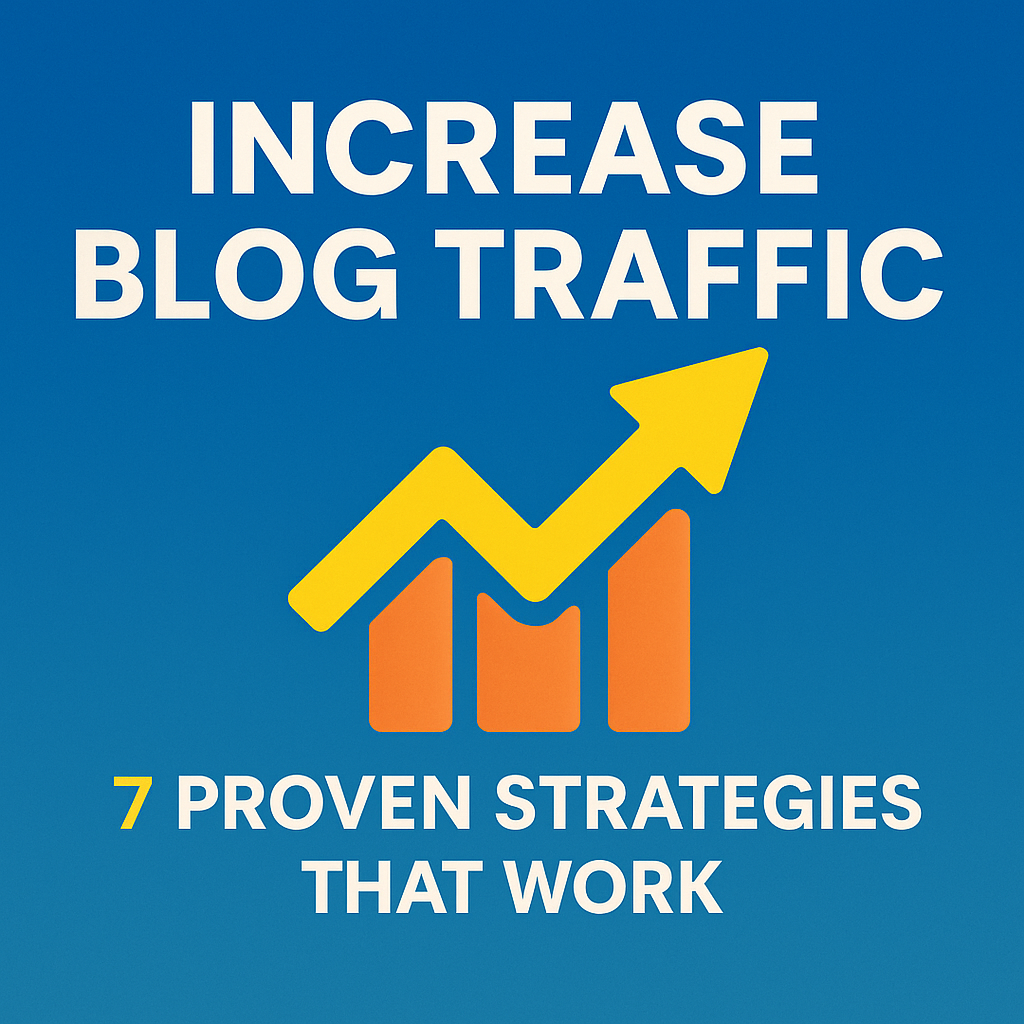Last Updated on November 12, 2025 by Team Digital Web Verse
Table of Contents
Why It’s So Hard to Increase Blog Traffic (At First)
Growing blog traffic in 2025 feels harder than ever. With millions of posts published every single day, it’s normal to hit zero views at first. But the good news? You don’t need to go viral or outsmart Google’s algorithm — focus on a few strategies that consistently bring readers to your blog.
In this guide, I’ll share 7 proven ways to increase blog traffic that actually work today. These are the same steps I used to move from “tumbleweed traffic” to steady growth.
1. Start With Content People Are Already Searching For
Blogging isn’t journaling (at least not if you want traffic). People don’t Google your experiences — they search for solutions to their own problems.
Instead of guessing topics, write posts around keywords people are already typing into Google. For example, if you’re blogging about blogging, “blog niche ideas” gets thousands of searches every month — while “My Blogging Journey So Far” doesn’t.
❓ Why this matters
People don’t Google your experiences — they search for solutions to their own problems.
So if your goal is to increase blog traffic, your content should answer actual questions.
✅ How to shift your approach
Instead of guessing, start with what people are already looking for.
Let’s say your blog is about fitness:
- Instead of: “Why I Switched to Intermittent Fasting”
- Try: “Intermittent Fasting for Beginners: What to Eat and When”
✅ How to find these ideas:
- Use Google Autocomplete and the “People Also Ask” box.
- Examine your competitors in your niche and identify what’s ranking.
- Use Ubersuggest or AnswerThePublic
The more your content aligns with what people already search, the faster you’ll increase blog traffic.
👉 Want inspiration? Check out my list of Blog Niche Ideas →
2. Optimize Every Post for On-Page SEO
Even the most helpful post won’t rank if it’s missing basic SEO signals. In 2025, Google rewards pages that show experience, expertise, authority, and trust (E-E-A-T).
❓ Why on-page SEO matters
Even the most helpful post won’t rank if it’s missing basic signals. SEO helps search engines know what your page is about, so they can actually show it to people searching.
✅ What to do (and where to use your keywords)
For each post, make sure your focus keyword (like “increase blog traffic”) appears in:
- The post title
- The URL (keep it short:
yourblog.com/increase-blog-traffic) - The intro paragraph
- At least one H2 heading
- The meta description
Then:
- Add internal links to your own content
(like how to start a blog or how to set up Google Analytics) - Add 1–2 external links to trustworthy sites (Moz, HubSpot, etc.)
- Use a free SEO plugin like Rank Math or Yoast SEO — both give checklists so you don’t miss anything
📝 Bonus tip: Use synonyms and related terms naturally throughout your post (e.g., “get traffic to your blog” or “ways to increase blog traffic”).
✅ Summary: Checklist for each post
1. Focus keyword in the title, URL, intro, H2, and meta description.
2. Add internal links to your other guides (e.g., SEO Blog Post Guide →).
3. Add 1–2 external links to trusted sites (Moz, Backlinko, HubSpot).
4. Use related terms naturally (e.g. “get traffic to your blog”).
5. Add FAQ schema or short Q&A sections to target “People Also Ask.”
🛠 Tool tip: Use Rank Math for a built-in SEO checklist.
💡 Looking to grow your blog faster this season?
The biggest Black Friday deals of the year are live!
Save up to 80% on hosting, SEO tools, and WordPress themes — all the essentials to start your blog.
👉 Grab the Best Black Friday Deals → Best Black Friday & Cyber Monday Deals (2025)
⏳ Updated daily as deals go live.
3. Promote Your Blog Beyond Google
Google takes time to send traffic. In the beginning, you have to promote your own posts.
❓ Why social promotion matters
Search traffic takes time. But social platforms? They’re instant. Even one helpful comment in the right group can get your blog in front of real people today.
✅ Best promotion channels in 2025:
- Facebook/LinkedIn groups → Great for networking and niche communities.
- Pinterest → Still one of the fastest free traffic sources for blogging, parenting, crafts, and lifestyle. Use Tailwind to schedule pins.
- Reddit & Quora → Perfect for answering niche questions (just don’t spam).
🛠️ Design Tip Box:
Want your Pinterest pins or blog graphics to stand out? Use Envato Placeit to whip up pro-looking pins, IG stories, or blog previews. (It’s faster than Canva and the templates are fire 🔥).
📌 Keep in mind: Don’t try to be everywhere. Pick 1–2 platforms and show up consistently.
💡 Pro tip: Always link to a freebie or lead magnet (like my Beginner Blogger Checklist) so you capture those visitors instead of losing them after one click.
4. Build Backlinks Without Being Spammy
Backlinks are like votes of confidence — the more quality sites link to you, the more Google trusts your blog.
❓ Why backlinks help increase blog traffic
Backlinks are like votes of confidence. The more quality sites that link to you, the more likely Google is to trust (and rank) your content.
✅ How to build backlinks in 2025 (without spamming):
- Comment on other blogs: Leave helpful, thoughtful comments on similar blogs. Some allow you to link your site in the name field.
- Join forums or Facebook groups: Share your blog naturally when answering questions
- Guest post swap: Find another new blogger and write for each other’s site
- Create link-worthy content:
- Original research
- Massive list posts
- Free tools or printables
- Answer HARO / Help a B2B Reporter requests.
- Create “link magnets”: ultimate lists, free checklists, or unique stats.
- Reach out after publishing: Email anyone you mention in your post.
Quick win: Post a “Best Resources for First-Time Parents” on your parenting blog. Then email everyone you included — some will link back or share it.
💡 Take your blog growth to the next level:
5. Use Email Marketing to Bring Readers Back
Not every visitor will come back on their own. That’s where email marketing makes the difference.
❓ Why email marketing matters
You own your list. No algorithm can take it away. And when you publish a new post, you can send it straight to people who already said they want to hear from you.
✅ Simple setup:
- Create a freebie: checklist, guide, printable, or email series (e.g., 10 Blog Niche Ideas PDF).
- Use Systeme.io to build your list — it’s beginner-friendly and free up to 1,000 subs
- Add a signup box in your sidebar, post footer, or use a slide-in popup
- Send short weekly emails linking to your latest posts.
Free plugin idea: Check out MailOptin or Hustle if your theme doesn’t include forms.
Once people join? Send short, value-packed emails with your latest post, a quick tip, or just a friendly check-in.
💡 Curious about Systeme.io? Here’s why I use it for my own blog list.
6. Track What’s Working (And Double Down On It)
You can’t grow what you don’t measure. The fastest way to double traffic is to identify what’s already working.
❓ Why this step matters
Instead of guessing what to write next, let data tell you. If one post brings most of your traffic, write more like that. If a post isn’t getting clicks? Update or repurpose it.
✅ What to track:
- Use Google Analytics + Search Console — setup takes 15 minutes
- Look at:
- Which posts get the most impressions in GSC.
- Which posts actually get clicks (CTR).
- Top traffic sources (Google, Pinterest, Facebook) and which traffic sources bring readers back.
- Which posts are getting the most visits
- What keywords are you ranking for
Action tip: Google loves updated content. Every 2–3 months, update your top posts. Add:
- New stats and fresh tips
- Extra internal links
- A refreshed meta description
7. Bonus: Test Low-Budget Ads (Only When You’re Ready)
If you have a little budget, you can give your content an early push with ads.
❓ When to use ads:
- You already have 10+ posts live.
- Your blog looks professional.
- You have an email opt-in or affiliate links in the post.
✅ What to do
- Boost your post on Facebook to a targeted audience — start with $5
- Try Pinterest Ads for content that already performs well organically
- Use Google Ads to target long-tail keywords
⚠️ In short – start small: $5–10 boosts on Pinterest or Facebook. But remember — ads should support your blog, not replace SEO and organic growth.
FAQs
What is the fastest way to increase blog traffic in 2025?
Focus on publishing SEO-optimized posts around keywords people already search for. Combine this with active promotion on one or two social platforms (like Pinterest or Reddit), and you can see traffic faster than relying on Google alone.
Does AI content help increase blog traffic?
AI can speed up drafting, but you still need to add your own insights, examples, and experience. Google values original perspectives, so treat AI as an assistant, not a replacement.
How can a beginner get the first 1000 visitors?
Target long-tail keywords, promote posts in niche communities, and interlink your articles. Most new blogs hit 1,000 visitors by combining SEO basics with at least one traffic channel like Pinterest or email.
Why isn’t Google sending me traffic yet?
New blogs often take 3–6 months before search traffic picks up. Keep posting consistently, optimize titles/meta, and check in Google Search Console to make sure your pages are indexed.
Should I run ads on a new blog?
Only if you already have at least 10 posts and a way to monetize traffic (like affiliate links or an email list). Ads can bring clicks, but organic growth is more sustainable.
Final Thoughts: Keep It Simple and Keep Going
Getting traffic to your blog doesn’t happen in a weekend.
But it also doesn’t require you to be a marketing genius. If you create content that solves real problems, optimize it properly, and show up consistently, the traffic will come.
Start with just one or two strategies from this list. Maybe SEO and Pinterest. Or blog comments and email. Then build from there.
✅ What’s Next?
Need help picking your theme, setting up hosting, or staying on track?
Grab our free Beginner Blogger Checklist — includes blog setup steps, SEO prep, monetization pointers, and more.
Or, if you’re ready to dive in:
👉 Make Money Blogging: Proven Ways That Actually Work →
👉 Ultimate Affiliate Marketing Guide for Bloggers →


